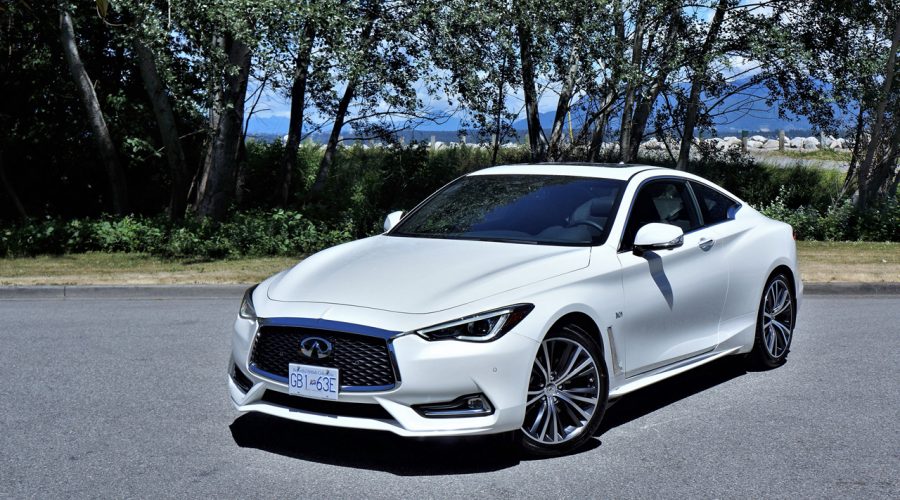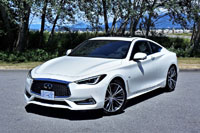
Twilight was causing headlamps and taillights to illuminate as I was driving home the other day, which is often a dazzling spectacle of white and red LEDs in my neighbourhood of premium and exotic machinery. Driving up to a stoplight and one set of particularly elegant rear lamps caught my attention, followed by a captivating silhouette. My eyes immediately locked in, because I wasn’t sure what I was looking at. All I knew was that it was gorgeous. Then I laughed when I realized I was looking at the current generation Infiniti Q60, a car that I’ve spent weeks with at a time on many occasion.

To be completely honest, I’m more than a bit jaded when it comes to cars. This job allows me to park some pretty impressive hardware in my driveway, and like I said a moment ago, every manner of BMW, Mercedes, Audi, Jaguar, Land Rover, Lexus and the list goes on crowd the highways and byways of my well-to-do city, not to mention more Ferraris, Lamborghinis, Maseratis and McLarens, plus Bentleys and Rollers than those living anywhere outside of Beverly Hills or Dubai will ever get the chance to see. So factor that in when considering an Infiniti pulled my eyeballs. This is one stunning looking car, no matter the angle.
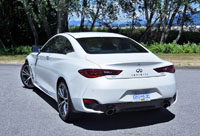
Another reason it caused me to look is rarity. The Q60 does pretty well compared to a Lexus RC, which it more than doubled in sales last year, but it’s not as strong a seller as say an Audi A5, a BMW 4 Series, or a Mercedes-Benz C-Class Coupe. Both the 4 and A5 more than tripled the Q60’s deliveries last year, and as Q3 2018 closed BMW had sold more than four times as many 4s and Audi had moved more than five times as many A5s, the new segment leader (although we can’t say for sure how many C-Class Coupes get sold each month as Mercedes lumps their sales numbers together with C-Class Sedans). And just in case you’re feeling sorry for Infiniti, consider BMW sold more than 12 times as many 4s and Audi more than 15 times as many A5s, while Infiniti found three times as many Q60 buyers. Ouch!
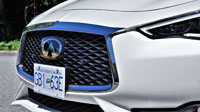
While slower sales might be a negative to a company’s balance sheet, it’s not necessarily a bad thing for premium buyers who want exclusivity. Let’s face it. In Canada’s better neighbourhoods the luxury wares from the big German brands are ubiquitous, causing their owners to spend umpteen thousands more for bespoke paint, fancy wraps, carbon fibre add-ons and expensive wheels, so therefore the opportunity to get into a car as stunningly beautiful as the 2018 Infiniti Q60 for just $46,295, or this 3.0T Luxe AWD that starts at $53,295, is rare indeed (see all of the 2018 Q60’s trims and pricing at CarCostCanada, plus save on your purchase by researching possible rebates and receiving dealer invoice pricing).
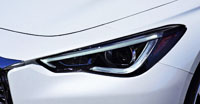
The base model just mentioned is the 2.0T Pure, a trim line and engine that will disappear on the Canadian market for 2019. If you can still find one and don’t care as much about forward thrust as beauty (because the car still looks as nice) its 208 horsepower Mercedes-sourced 2.0-litre turbocharged four-cylinder engine is plenty fuel-efficient, but most Q60 buyers opt for Infiniti’s own 3.0-litre turbocharged V6 that makes a much more formidable 300 horsepower and 295 lb-ft of torque, which I have to say is more than adequate, as long as you don’t try the Q60 Red Sport 400 with its same number of horses and 350 lb-ft of ready and willing torque.
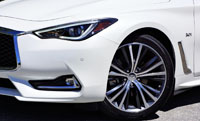
That’s a car I’ve previously covered and hope to again soon, but its $61,295 price point might be a bit dear for some, hence the $55,295 Q60 3.0T Sport just below and the Q60 3.0T Luxe I spent a week with. Before I delve into Infiniti’s value proposition, which is always a key reason to consider the Japanese luxury brand, let’s talk driving dynamics.
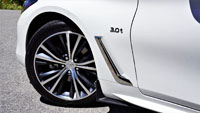
First off, it’s an easy car to drive around town and on the open highway, as one might expect by looking at its classy chrome detailed exterior and luxuriously appointed leather, hardwood and bright metal lined interior. The ride is firm yet comfortable, its standard 19-inch machine-finished alloys on 255/40 all-season run-flats not helping the former, but its double-wishbone front and multi-link rear suspension making sure of the latter. Infiniti has tuned the spring rates, dampers and stabilizer bars for a competent mix of compliant performance, and while not quite as capable as the Dynamic Digital Suspension included with the Q60’s two top-tier Sport trims, its agility around corners shouldn’t leave anyone wishing for too much more.
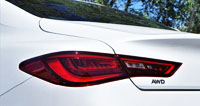
Speaking of more, Infiniti offers the Q60 with the complexity of four different steering systems depending on engine, trim and your willingness to pay. The base model I mentioned earlier comes with a vehicle-speed-sensitive hydraulic electronic power steering setup, while the car I tested features standard electronic power steering, yet is offered with Infiniti’s exclusive Direct Adaptive Steering, which replaces mechanical linkages with electronic switches and servo motors to save weight and further enhance the driving experience. Lastly, those two just noted Sport trims can be had with the optional direct steering system or come standard with a more performance-oriented fast ratio electronic power steering setup.
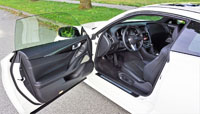
As with the suspension, I never felt any lack of response when pushing the Q60 hard through corners, something I did as often as opportunity allowed. Instead, all that was needed was a little tap on the sizeable 12.6-inch front and 12.1-inch rear discs to load up the front tires and the wonderfully tuned chassis took care of the rest. Infiniti includes standard Active Trace Control that actually enhances cornering feel by modulates braking and engine torque, and I’ve long been a fan of the brand’s rear-biased Intelligent all-wheel drive that sends all available twist to the wheels in back until tire slippage transfers up to 50 percent of torque forward to the front wheels.
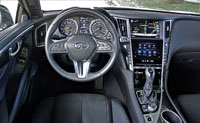
Rear tire slippage can happen when getting hard on the go pedal, although you won’t notice any such torque transferring going on behind the scenes. All you’ll feel is immediate response from throttle input, its torque strongest between 1,600 and 5,200 rpm, which considering its aforementioned 295 lb-ft of twist is a nice broad spectrum that allows what seems like relentlessly quick acceleration.

It feels especially potent when Infiniti’s Drive Mode selector is switched to Sport mode. It was quick enough in the default Standard setting, while Snow, Eco and Personal modes are also included, but Sport is best for lickety quick shifts from the wonderfully engaging seven-speed automatic that snaps to attention at takeoff or alternatively quickly drops down through the gears to find the ideal cog for passing manoeuvres. Shift intervals are nice and crisp, but to be fair this isn’t the sportiest transmission in this class, yet it’s certainly one of the best for simultaneously providing quick responses and ultra-smooth operation.
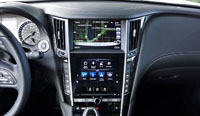
Truly, Infiniti has really done a wonderful job with this gearbox, while along with its quick reacting performance comes Downshift Rev Matching (DRM) that makes you look and sound like a pro as the engine automatically blips to ideally match a chosen gear; a driver-adaptive learning algorithm that senses your driving style and then adjusts its shifting accordingly; Adaptive Shift Control (ASC) that gets upgraded with navigation system synchronization in Luxe trim and above, which adds GPS mapping data to the usual sensor-based system in order to automatically select shift points when the transmission is left to its own devices in Drive, selecting the best possible gear depending on uphill, downhill or curving road conditions; plus dual automatic transmission fluid coolers to keep it running smoothly and reliably.
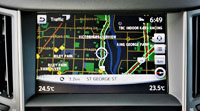
I only wish steering wheel-mounted paddles were included with V6-powered cars, and not only with the aforementioned Sport trims. This more pampering Luxe trimmed example is certainly sporty enough to warrant paddle shifters, and I for one would feel a bit put off if I paid $50k-plus for a performance coupe and wasn’t able to enjoy the hands-on control that paddles provide.
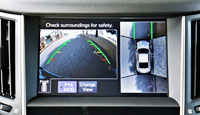
That Eco mode mentioned earlier is a pet peeve of mine, and not because it strangely still doesn’t include an auto start/stop function. While it seems to work pretty well for saving fuel, it incorporates one of my most disliked features of any car made anywhere. The Active Eco Pedal pushes back on your right foot when attempting to apply more throttle than it feels is necessary to maximize fuel economy, and I loathe this so much that I purposely won’t use Eco mode. Of note, I often use Eco mode with Infiniti’s competitors, as I like saving fuel when driving in the city, but I find the Active Eco Pedal so disturbingly intrusive that I’d rather pay more for less driving interference. Go ahead and search for it online and you’ll quickly see my distaste for this device isn’t unique, and I’m willing to be the sooner Infiniti gets rid of it the faster people will want to purchase its cars. On the positive, this version doesn’t push back as aggressively as early versions, but it still feels as if you’re pushing down on a block of wood instead of a nicely progressive gas pedal.
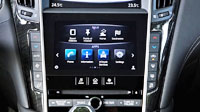
Speaking of economy, the new 3.0-litre V6 is much more fuel-efficient than the previous 3.7-litre version, with my weeklong non-Active Eco Pedal usage measuring a combined 11.7 L/100km from mostly city and some highway driving, which comes fairly close to matching the claimed Transport Canada rating of 12.3 city, 8.6 highway and 10.7 combined. The soon-to-be-discontinued four-cylinder gets a thriftier 11.2 city, 8.5 highway and 10.0 combined rating, by the way, which really isn’t all that much better than the V6, while the brilliantly quick 400 horsepower Red Sport version is good for an estimated 12.5 city, 9.2 highway and 11.0 combined, which once again isn’t much of a penalty for its superb performance capability.
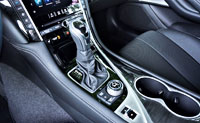
I’ll refrain from deep diving into every last feature and option available to Q60 buyers this time around, mostly because this review is coming out towards the end of the 2018 model’s availability and the 2019 will see plenty of changes to trims and feature sets as noted earlier, but suffice to say this current model year and the next one offer premium buyers loads of value. For example, a shortlist of standard features found on the base Pure model include such niceties as full LED headlamps, proximity keyless access, pushbutton ignition, signed aluminum treadplates, genuine aluminum interior inlays, dual-zone auto HVAC, Infiniti InTouch dual display infotainment with an 8.0-inch top monitor and 7.0-inch lower touchscreen, a reverse camera, voice recognition, text message capability, satellite radio, a powered moonroof, eight-way powered front seats with power lumbar support, rear parking sensors, Scratch Shield self-healing paint, plus all the usual active and passive safety features.
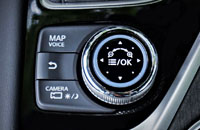
Along with the more powerful engine, my 3.0T Luxe tester added remote start, auto-dimming side mirrors, a heatable power tilt and telescopic steering wheel, heatable front seats, memory for the steering wheel, seats, and side mirrors, soft perforated semi-aniline premium leather upholstery, accurate navigation with lane guidance and 3D building graphics, the navigation-synchronized adaptive shift control I mentioned earlier, real-time traffic info via SiriusXM Traffic, superb sounding 13-speaker Bose Centerpoint surround audio, a garage door opener, powered front seat torso bolsters, and more.
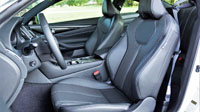
Infiniti added $750 worth of Majestic White Pearl paint, plus the $5,200 ProAssist-ProActive package that includes rain-sensing wipers, auto-leveling front headlamps with adaptive cornering, front parking sensors, an Around View Monitor (AVM) with Moving Object Detection (MOD), Predictive Forward Collision Warning (PFCW), Forward Emergency Braking with Pedestrian Detection (PFEB), Blind-Spot Warning (BSW), and Back Collision Intervention (BCI) with Rear Cross Traffic Alert (CTA), which proved to be a useful collection of advanced driver assistance features that worked well without being overly sensitive.
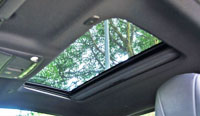
All of this advanced equipment comes in an interior that’s beautifully finished with high-quality materials. Its dash-top is all soft touch synthetic, and stitched together with contrasting thread. Infiniti provides the same impressive treatment across the entire instrument panel, all the way down to the lower console where it turns into an even softer padded leather wrap. This even includes the glove box lid. Likewise, the door panels are finished in this comfortable leather-like material from top to just under the armrests, with contrast stitching throughout—only the lower door panels are finished in a harder plastic, which unfortunately is all too common in this class.
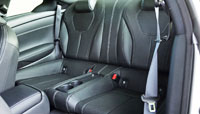
Infiniti enhanced the leather with a rich looking, substantive feeling dark grey hardwood, plus lots of attractive satin-finish aluminum. It’s all tastefully put together for a classy result, while some of its switchgear is edged in knurled metal for extra grip and a ritzier look. Even nicer, the previously noted Bose stereo includes gorgeous drilled aluminum speaker grates on the front doors. Yes, it’s easy to fall in love with the Q60 interior.
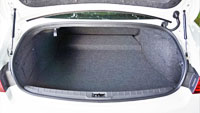
I’d like to see more graphical information within the gauge cluster’s multi-information display, or better yet a fully configurable TFT gauge package, but nothing like this is on offer yet. Instead, you get a simpler colour display between two analogue dials ahead of the driver, plus the aforementioned dual display infotainment system that provides more digital acreage than the majority of competitors. The top display is controlled by a rotating knob on the lower console, and the bottom display is a regular touchscreen, and while it all looks impressive initially, the latter lacks the ability to use tap, swipe and pinch gesture controls for the map, forcing you to execute such functions on the rotating dial. The latter function works reasonable well, it’s certainly not as intuitive as a regular touchscreen, which most of us are used to due to our smartphones and tablets.
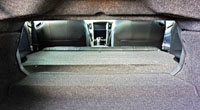
The perforated leather driver’s seat was wonderfully comfortable, and offered good lateral support made better via powered torso bolsters. This said I’d rather they included four-way powered lumbar support instead, but at least the fore and aft design came very close to pushing in at the ideal spot on the small of my back. Also on the positive, Q60 ergonomics fits my body like a glove. Its powered steering column has plenty of reach, while the seat is as adjustable as I could ever need, thus optimizing my driving position for total control and comfort. As I said over and over again in my reviews, this isn’t always the case due to my unique long-legged, short torso body type.
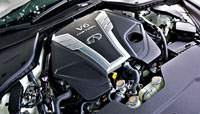
Rear seating space is tight of course, which is par for the course in the personal coupe category, especially amongst compact D-segment models. This said I had about four inches in front of my knees when the driver’s seat was set for my five-foot-eight medium-build frame, plus ample room for my feet and about an inch above my head to the window glass. I had reasonable side-to-side room as well, measuring about three inches from my outside shoulder and four inches from the hips, while Infiniti does not provide a centre armrest in back, but a centre console includes a shallow tray and equally shallow cupholders. The seatbacks are fairly comfortable, but I wouldn’t want to sit in the back over a long haul.
Now that I’m kind of complaining, I’m still not a fan of foot-operated parking brakes, mostly because they get in the way. Then again with the Q60 it’s not as much of a problem because no manual gearbox is offered.
It would be silly to complain about the Q60’s small 246-litre (8.7 cubic-foot) trunk, because most personal coupes don’t offer a lot when it comes to cargo carrying capacity. Fortunately it’s nicely finished with carpeting all the way around, plus Infiniti filled the empty spare tire hole with a handy tool kit holder. The rear seat folds forward, but take note there’s no split at all, which limits cargo/passenger flexibility.
Perfect it’s not, but factor in all you get with the 2018 Q60, from its potent and efficient powertrains to its gorgeous styling and ultra-rich cabin, not to mention its impressive load of standard features and optional kit, and it’s a lot of personal luxury coupe for a very reasonable price range. On looks alone I could recommend it, but it’s so much more than just a pretty face. If you want a truly special sports coupe that you won’t see coming around every other corner, I recommend you pay special attention to the Infiniti Q60.

